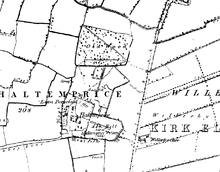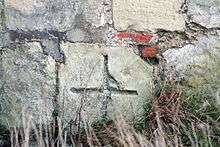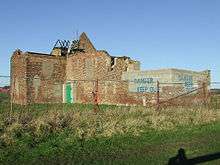Haltemprice Priory
Haltemprice Priory was an Augustinian monastery approximately two miles south of the village of Cottingham in the East Riding of Yorkshire, England. The original monastic buildings have long since gone, although ruins of a farmhouse, built in 1584, remain on site and incorporate some of the Priory stonework.
| Haltemprice Priory | |
|---|---|
| Religion | |
| Affiliation | Augustinian |
| Ecclesiastical or organizational status | Priory |
| Year consecrated | 1326 |
| Location | |
| Location | Willerby, England |
| Geographic coordinates | 53.764613°N 0.420900°W |
Origins
In 1320 Pope John XXII licensed Thomas Wake, of Liddell in Cumberland (who inherited the manor of Cottingham in 1300), to found an Augustinian monastery in Cottingham incorporating the church there. Some records suggest that the first Priory was actually built, and that canons of the house of Bourne in the Diocese of Lincoln had taken up residence there when legal complications arose.
It was discovered that, because of certain statutes of English law, Thomas Wake's heirs or successors would have been able to order the future demolition of the Priory. It was for this reason that the Pope granted further licence that the Priory should be moved to another suitable location, so it was with permission from both the Pope and Edward II that Thomas Wake moved the monastery to Newton – a now deserted medieval village two miles south of Cottingham.
History

Foundation
In the foundation charter of 1325, Thomas Wake bestowed the manors of Newton, Willerby and Wolfreton upon Haltemprice Priory (originally Alta Prisa, from the medieval French Haulte Emprise or "High Endeavour", giving the modern name Haltemprice) with the rent and services of the free tenants and serfs therein. He also gave half the toll of the market of Cottingham, and of the fairs there, and the advowson of the churches of Cottingham, Kirk Ella, Wharram Percy, and Belton in the Isle of Axholme
Heyday, 1320–1342
During 1320 to 1342, Haltemprice Priory experienced its heyday. At the peak of its influence, the Priory controlled a large swathe of land extending from Willerby to Cottingham, Kirk Ella and Southwood. Despite the personal, political, financial and military problems affecting him – including the capture of his castle at Liddell by King David of Scotland – Thomas Wake continued to bestow gifts upon the priory until 1342 when records of further benefactions cease. Sir Thomas died in 1349 and was interred at the priory.
Decline, 1342–1534
From 1342 to 1534 the Priory's fortunes turned. A combination of mounting debt, administrative incompetence and a string of expensive litigation drained the ecclesiastical finances to the point where Priory could no longer be sustained by the flow of donations it received from its benefactors.
The situation was dire, and at the time of Sir Thomas's death in 1349 the construction of the Priory was still not fully complete. Since then – with the decline in finances – the Priory had fallen into an even worse state of disrepair. In a report issued to Pope John XXIII (Antipope) in 1411 it was revealed that a gale had blown down the bell-tower, ruining the church and other buildings and that a fire had destroyed the Priory gateway and nearby offices. The Priory was in such a bad state of disrepair it afforded poor accommodation for those living there.
From 1415 to 1458 Haltemprice Priory was made exempt from royal taxation on grounds of 'notorious poverty'.
In 1515 a dispute came to pass between John Wymersley, the Prior of Haltemprice, and Edward Mattison, the Sheriff of Hull, over who possessed legal authority over Willerby and Wolfreton. A battle ensued, only to be broken up by the Mayor of Hull, and settled in the Court of Star Chamber – three years later. The final ruling allowed Hull control of the freshwater springs conceding the royalties of Willerby and Wolfreton to the Priory.
Dissolution

During the Dissolution of the Monasteries orchestrated by Henry VIII the house was visited by commissioners Richard Layton and Thomas Legh. On 26 May 1536 they reported that the house was occupied by a prior and nine canons along with forty servants and boys. Haltemprice Priory was finally dissolved on 12 August 1536.
Priors of Haltemprice
| Name | Start of Office | End of Office |
|---|---|---|
| Thomas de Overton | 1327 | died 1328 |
| Robert Engayne | elected 1329 | resigned |
| John de Hickling | confirmed 1331 | |
| Thomas de Elveley | confirmed 1332 | resigned 1338 |
| William de Wolfreton | 1338 | died 1349 |
| Robert de Hickling | 1349 | resigned 1357 |
| Peter de Harpham | 1357 | resigned 1362 |
| Robert de Hickling | elected 1362 (? second time) | occurs 1367 |
| Peter (?de Harpham a second time) | occurs 1370 | |
| Robert Claworth | died 1392 | |
| William de Selby | confirmed 1391–92 | occurs 1414 |
| Richard Worleby | occurs 1415 | resigned 1423 |
| John Thweng | elected 1424 | (occurs 1425, 1430–35, 1437) |
| Robert Thweng | occurs 1435 | 1439 |
| Thomas Dalehouse | elected 1441 | resigned 1457 |
| Robert Holme | confirmed 1457 | |
| William Maunsel | elected 1471–72 | died 1502 |
| William Kirkham | 1502 | died 1506 |
| John Wymmersley | 1506 | died 1514 |
| John Nandyke | confirmed 1514 | occurs 1517 |
| Nicholas Haldesworth | elected 1518 | |
| Richard Fawconer | elected 1528 | resigned 1531 |
| Robert Colynson | elected 1531–32 | last prior |
Haltemprice Priory Farm

Haltemprice Priory Farm dates from the 15th to 16th century with late-18th-century alterations. The structure is thought to incorporate stonework from the dissolved priory.[1] The farm was occupied up to 1988; it became derelict, and suffered fire damage in the late 1990s and early 2000s. The building is designated as a Grade II* Listed Building of Special Architectural or Historic Interest and was first listed in 1951. The priory site itself is classified as a Scheduled Monument, first scheduled in 1957.[2] The farm is on the Heritage at Risk Register.[3]
References
- Historic England. "Haltemprice Priory Farm (1103364)". National Heritage List for England. Retrieved 16 April 2012.
- Peter Gaze Pace (chartered architects) (September 2011). "Haltemprice Priory Farmhouse, Abbey Lane, Willerby, Hull HU10 6ER, Scheduled Ancient Monument SM 32639. Proposed re-instatement as a single domestic dwelling" (PDF). East Riding of Yorkshire Council. Archived from the original (PDF) on 19 April 2012. Retrieved 5 December 2012.
- "Haltemprice Priory Farmhouse". Heritage at Risk. Historic England. Archived from the original on 29 October 2013. Retrieved 20 June 2015.
Sources
- Hayton, Richard. "Haltemprice Priory". Archived from the original on 16 May 2011. Retrieved 25 July 2013.
- Page, William, ed. (1974). A History of the County of York, pp. 213–216. University of London, Institute of Historical Research. ISBN 0-7129-0611-8.
- Spence, Joan; Spence, Bill (1981). The Medieval Monasteries of Yorkshire. Ambo Publications. ISBN 0-906641-00-4.
- Stamp, A.H. (M.A.,Ph.D.) (1989). A Brief History of Haltemprice Priory. Cottingham Local History Society.
External links
| Wikimedia Commons has media related to Haltemprice Priory. |
- Historic England. "Haltemprice Augustinian priory (1019825)". National Heritage List for England. Retrieved 5 December 2012.